The Lawmatics Blog
Insights on legal marketing, automating the law practice, and legal tech in general
As we head toward the end of the year, our team revisited the most meaningful product updates of 2025 and how they’re reshaping the way firms work. All year long, our product work has centered on the same core goal: removing the obstacles that slow firms down. That’s meant bringing key information to the surface when teams need it, cutting out friction in the client journey, and giving staff clearer ways to build and maintain their processes across the platform.
Time stamps of key takeaways
8:15 – New, intuitive navigation
Devon walks through the redesigned navigation, which brings the most-used areas — like Matters, Pipeline, Calendar, Tasks, and Automations — into a cleaner, left-hand layout for quicker access. Reminders, emails, and other tools that had previously been scattered across the app now live in central, easy-to-find locations. The goal is simple: fewer clicks, clearer groupings, and a workspace that reflects how firms actually move through intake.
26:20 – Get key info faster with MMS
The team shows how firms can now receive MMS messages directly into Lawmatics, allowing clients to text photos or documents straight into their matter. It’s especially useful for practices like personal injury, where images of an accident or ID documents are often needed quickly.
31:18 – Manage your emails in one place
Email tools have been fully centralized, replacing the old model where templates lived in different corners of the app. Everything — from document send templates to automation emails — can now be created, edited, and organized in one place. Folders help firms manage growing libraries of emails, and each template can be applied across multiple documents without duplicate versions.
36:55 – Build and maintain automations with less effort
Devon and Clare highlight the refreshed automation experience, which makes appointment-based and date-based workflows easier to find, build, and understand. Relative timing is now built directly into each automation, and shared entry rules help firms avoid recreating the same logic dozens of times. Automation builds can also now be grouped in folders, similar to how you organize your email library.
45:18 – Additional highlights
The session closes with a handful of smaller but long-requested additions, including improvements to round-robin scheduling, password-protected forms, Message Center filters, auto-pay for billing, and color-coded appointment types to make dense calendars easier to read.
Webinar slide deck
Growth comes from converting the leads you're already paying to attract.Most firms generate more interest than they convert. A referral that didn’t get a reply. A form fill that went unanswered. A no-show that was never rebooked. Without structure, those opportunities sit idle, and marketing dollars go unused.So how do you make the most of every lead?Here are five practical rules to help your firm respond faster, follow up more consistently, and turn missed connections into steady revenue.
Rule 1: Respond the way clients expect
Speed matters, especially at first contact.When a prospective client reaches out, they’re often in a moment of stress, urgency, or uncertainty. They expect the same responsiveness they’ve come to rely on in other industries: immediate acknowledgment, clear next steps, and an easy way to move forward.In 2024, 28% of law firms responded to online leads in under five minutes, up from 18% the year before, according to Hennessey Digital’s annual industry study. The firms that meet that mark set the pace for everyone else. When responses lag, many prospective clients keep looking. In fact, Martindale-Avvo identified slow response times as the #1 red flag for consumers when hiring an attorney.Delays in response time often stem from inefficiencies in the intake process. Teams rely on shared inboxes, spreadsheets, or manual follow-up systems that break under volume and pressure.High-performing firms build structure into their intake. With automation, they respond in real time and make a strong first impression. So each response includes:
- Confirmation that the message was received
- Clarity about what happens next
- A direct link to schedule a call or consultation
The message doesn’t have to be complex. It just needs to be consistent. A prospective client should get the same prompt, professional experience whether they were referred, clicked on an ad, or called after business hours.These early moments shape perception. When your firm shows up fast, with clarity and care, trust builds, and more leads become clients.
Rule 2: Make speed to lead part of the system
When intake depends on memory, inboxes, or spreadsheets, response time breaks down. Each new inquiry creates questions: Who follows up? Has someone already responded? What’s the next step?Even with the best intentions, these small delays lead to missed opportunities.The first ten minutes after a lead reaches out are often the most important. That’s when they’re focused, available, and ready to engage. If your team doesn’t respond during that window, the chance of conversion drops.Speed to lead improves when it’s built into the intake process. A structured system can automatically:
- Alert the team when a new inquiry comes in
- Assign it to the appropriate intake coordinator
- Launch a predefined set of follow-up tasks
This type of intake design supports consistency, regardless of volume. It helps the team stay responsive, not just when things are slow, but when the calendar is full. When responsibilities and next steps are defined in advance, follow-up happens without confusion or delay. Every prospective client gets a clear, timely response, and the intake team stays focused on high-value conversations.Whether your firm fields ten inquiries a week or manages hundreds each month, structure ensures each one is handled with the same level of attention without overloading the intake team.
Rule 3: Use lead source to guide the first touch
Anyone who calls a law firm starts the process with different expectations. A referral may already trust your firm. A pay-per-click (PPC) lead likely doesn’t and is still deciding whether to engage. Treating both the same undermines the first impression.When firms send identical responses to every lead, the message often misses the mark. That initial reply is a key moment to reinforce confidence and create momentum. A referral may need warmth. A PPC lead may need speed and clarity.Tailoring the message by source strengthens both. For referrals, a more personal tone goes a long way: “Thanks for reaching out. [Referrer’s name] said you might be looking for support. Let’s find a time to connect.” That type of reply acknowledges the relationship and sets a respectful tone.For ad-driven or site-generated leads, a fast, actionable response builds trust: “Thanks for contacting us. You can schedule a consultation here [link]. We’ll confirm and follow up with details.” This shows that your firm is responsive and organized, which are key signals for those unfamiliar with your brand.These reply types can be routed automatically based on lead source no manual steps required. With a few structured rules, your system can send the right message to the right contact at the right time. Tailoring intake by source improves engagement, sets a professional tone, and reflects the client-first experience that growth-focused firms are known for.
Rule 4: Segment early to stay relevant
Every lead brings a different context and different expectations. Some are ready to move forward. Others are still evaluating options. But if every new contact gets the same response, relevance suffers.When replies don’t match the lead’s urgency or intent, engagement drops. A research-phase lead may disengage if pressured to book. A high-intent contact may move on if they don’t get a clear next step. Strong intake systems solve this by segmenting early, often before the first reply goes out. Most do it in the background, using logic based on form fields, source, or behavior. Lead tags are applied automatically, classifying contacts by urgency, interest, or stage.This kind of segmentation allows intake teams to respond with clarity and precision. A contact who clicks “book a consultation” can be tagged as high priority and routed for immediate follow-up. Someone downloading a resource may receive a lighter-touch sequence, with future check-ins based on activity.Priority indicators take it further. Based on signals like call requests, time of inquiry, or stated timeline, each lead can be ranked. That helps the team focus attention where it’s most needed.When segmentation is systematized, teams aren’t making case-by-case decisions under pressure. They’re following clear logic that ensures timely, appropriate follow-up, without sacrificing quality. Growth-minded firms know that people contacting your firm don’t expect perfection, but it will keep potential clients engaged through the process if the outreach feels timely and personalized.
Rule 5: Build intake as a growth engine
In a client-driven firm, intake is more than an administrative task. It’s the moment where interest turns into action. So, when intake systems lack structure, results suffer. Leads fall through. No-shows rise. High-value contacts lose interest. And with no visibility into what’s happening, teams can’t tell what’s working or why conversion lags.Shifting intake into a growth function starts with measurement. Intake data should tie directly to business performance. At a minimum, firms should monitor:
- Time to first response
- Consults booked per inquiry
- No-show rate
- Conversion by lead source
With the right systems, these numbers inform action. A rise in no-shows might point to gaps in scheduling or reminder messages. If one source consistently converts, the marketing budget can be realigned. Intake becomes a performance lever, one that drives smarter decisions across marketing, staffing, and client service.Structure also reduces friction. When next steps are built into the process, staff spend less time tracking and more time engaging. Alerts, task routing, and message templates help the team prioritize follow-up without reinventing it each time.Firms that structure intake around timely follow-up and measurable outcomes consistently report stronger conversion and clearer insight into what’s driving growth. Treating intake as a growth lever doesn’t require overhauling your operations. But it does mean designing intake with purpose so every inquiry has a clear path forward, and every effort supports firm growth.
Systems create predictable growth
Structured intake creates business stability. With clear rules and repeatable actions, law firms can handle growth without sacrificing responsiveness or quality. Intake becomes a system that supports long-term performance, not just daily tasks.Each of the five rules shared here contributes to that foundation. They establish the principles behind a more consistent, more confident intake process: fast responses, relevant messaging, and clear priorities. When those elements are built into the system, intake becomes a driver of growth and client trust.The next step is operational. Firms that define their workflows, messages, and logic up front create an intake experience that’s easier to manage, easier to scale, and aligned with how legal consumers actually make decisions.If you want to see how that looks in practice, get a demo of Lawmatics. We’ll walk you through how the platform helps firms respond faster, follow up consistently, and convert more of the leads they’re already paying to attract.
Intake is often the first real interaction a prospective client has with your firm — and the experience matters. The right form doesn’t just collect information; it sets the tone, guides the conversation, and lays the groundwork for everything that follows. That’s why building a single, thoughtful intake form can have an outsized impact on your workflow, your team’s efficiency, and how clients experience your brand from day one.To dig into what that looks like in practice, Lawmatics Product Manager Devon Butler teamed up with Clare Struzzi from our account management team for this month’s Deep Dive webinar. They covered everything from the fundamentals of form building to more advanced features like conditional logic and automation triggers.
Time stamps of key takeaways
7:00 – Custom form builder
Devon kicks things off with a walkthrough of the custom form builder, starting with the basics like naming conventions and form types. She also explains the different field types you can use (standard, contact, matter, company) and how to think about them when building a form that fits your intake process. The focus here is on creating something that’s both flexible and easy for your team to use consistently.
15:41 – Adding advanced elements
Devon and Clare go over enhancements like booking blocks, file uploads, and general form-only fields. General form-only fields live only on the form and don’t clutter up your matter pages — great for questions you don’t need to track long-term, like a detailed list of client assets. This portion also covers relationship blocks, perfect for collecting info for a client’s spouses or kids.
29:51 – Using conditional logic for smarter forms
Here, Devon introduces a key strategy: using conditional logic to tailor the form experience. Instead of overwhelming people with a wall of questions, you can have fields appear only when they’re relevant, like only showing spouse info when "married" is selected. Conditional logic is also a handy way to trigger follow-ups or route leads to the right next step, depending on how they answer.
37:02 – Trigger automations with form responses
Devon shows how you can connect your forms directly to automations. For example, if a consultation gets booked, an email or text confirmation goes out automatically. The key is using custom and standard fields to kick off the right workflow, so your team doesn’t have to remember to do it manually.
Webinar slide deck
As law firms grow, so do the complexities of managing both new leads and active cases. That’s why firms turn to purpose-built software to support each phase of the client journey, from intake to active cases and beyond. But having the right tools isn’t enough. Growth doesn’t come from stacking tools; it comes from connecting them in ways that simplify work and strengthen the client experience.In our latest webinar, we were joined by Amanda Connolly, senior account manager for partnerships at MyCase, to break down the differences between CRM and case management platforms, and how the two software complement each other over the course of the full client journey.
Time stamps of key takeaways
6:59 — Defining CRM and case management
Blake and Amanda opened the session with a clear breakdown of CRM versus case management platforms. CRMs are designed to manage leads and long term relationships, while case management systems take over once a client signs on. Think of the CRM as your engine for intake, marketing, and referrals, and case management as your legal operations hub.
11:21 — How the platforms work together
It’s important to view the client experience as a full journey, from first touch to final invoice. CRMs help with both prospects and former clients, while case management handles everything for active matters. Integrated properly, the two systems ensure a seamless, end-to-end experience for both clients and staff.
23:22 — Tracking & reporting across systems
Tracking data across both platforms provides valuable visibility into what’s working and where things fall off. By combining CRM and case management insights, firms can uncover trends, identify bottlenecks, and make better-informed business decisions all from a single source of truth.
27:29 — Keys to success for scaling systems
Rather than piling on more tools, growth-minded firms focus on making their existing systems work smarter. Blake and Amanda shared practical tips for aligning tech with firm goals, building simple and effective processes, and setting teams up for success through thoughtful implementation and training.
41:03 — Highlights from the Q&A
The Q&A touched on common pain points and practical solutions. Attendees asked about syncing data across platforms, training teams effectively, and where automation adds the most value. One clear takeaway: Firms want technology that feels like an extension of their team, not another tool to manage.
Webinar slide deck
In a crowded legal market, it’s not enough to simply generate leads. You need a clear plan for what happens next. That’s why we recently teamed up with CallRail’s Chris Nelson — to walk through how law firms can keep prospects engaged from first contact all the way through completed intake.This session covered what today’s legal consumers expect, how to tailor your communication, and how to build a workflow that drives more conversions with less manual effort. Below, we’ve rounded up the key takeaways and timestamps so you can jump right in.
Time stamps of key takeaways
6:55 — Why slow follow-up costs firms clients
Blake and Chris open the session by emphasizing how the legal buyer’s journey has changed — and why firms need to rethink their follow-up process. Most prospective clients reach out to law firms by phone, and 78% of clients hire the first firm to respond. These trends in client behavior mean law firms need a clear strategy to keep prospects engaged and moving forward at every step.
22:50 — Understanding who you’re targeting & how to reach them
Blake walks through how to define client personas based on practice areas, goals, and psychographics — and how those insights shape your communication. When you understand what your ideal clients care about and how they prefer to interact, it becomes easier to send the right messages at the right time. As Chris puts it, nurturing leads is like preparing a case for trial: Know your audience, tailor your message, and connect in a way that resonates.
40:44 — Map your process and prioritize the right leads
Chris stresses that there’s no one-size-fits-all approach to follow-up. Your workflow should reflect your firm’s goals, client expectations, and available resources. Together, he and Blake walk through how to break down your intake and follow-up process into specific stages, track what’s working, and continuously refine from real client behavior. They also introduce lead scoring as a way to gauge readiness and ensure you're spending time on the right prospects.
48:56 — Let technology do the heavy lifting
Blake and Chris close by showing how tools like Lawmatics and CallRail reduce the burden of manual follow-up. Automation handles things like scheduling emails and prompting reminders, while reporting tools give visibility into open rates, drop-offs, and what messages actually convert. Together, these tools help firms avoid missed opportunities, without adding more work to the day.
Webinar slide deck
Chasing down payments? Not exactly the dream when you started your law firm. Whether it’s prospects who never paid their consultation fee or leads dragging their feet on a retainer, the early stages of client onboarding can get bogged down fast. And when payment isn’t built into your intake process, it usually falls on someone’s shoulders to follow up, again and again.In this month’s Deep Dive, Lawmatics Product Manager Devon Butler walked through how to make payments a seamless part of your intake process. Joined by Sr. Director of Customer Success Johnny Bissell, she demoed how to add fees to forms, automate retainer collection, send receipts without lifting a finger, and keep tabs on every transaction along the way.
Time stamps of key takeaways
8:45 — Add consultation fees directly to your intake forms
Devon shows how easy it is to drag and drop a payment block onto your intake form using LMPay. You can set a flat fee, pick the bank account, and even use conditional logic to adjust pricing based on client responses. Johnny points out that this flexibility makes it simple to create one form that works for multiple appointment types.
15:41 — Collect retainers as part of your intake process
Need to collect a retainer before officially taking on a client? Devon walks through how to build that right into your automations — so once someone signs an agreement, the invoice goes out automatically. Johnny jumps in with ideas for customizing this based on package types or service tiers, making the process feel personal and polished.
32:43 — Automatically generate and send payment receipts
As soon as a payment is processed, Lawmatics can immediately send out a receipt. Devon shows how to tailor what’s included, like attaching the original invoice or just the receipt. It’s all handled behind the scenes, and yes, it waits until ACH payments actually clear.
35:07 — Monitor payments received from prospective matters
Keeping tabs on payments is simple with the invoices and activity views. Devon demos how to track what’s been paid, what’s still processing, and what might’ve failed. You can even issue refunds, if needed. Johnny notes that with the Time & Billing add-on, you can go even deeper, slicing your data by team member, payment method, or client type.
Webinar slide deck
It’s not just about landing the client — it’s about what happens next. For most law firms, the biggest growth opportunities aren’t in getting more leads, but in doing more with the ones they already have. From intake to invoicing to ongoing engagement, there are countless touchpoints where firms either build long-term value — or lose it.In this Lawmatics webinar, Brent Harkins, chief marketing officer at US Legal Marketing Group, laid out seven high-impact ways to strengthen the client journey and increase the lifetime value of every relationship. Whether you’re looking to improve your intake process, tighten up billing, or boost referrals, these key takeaways are a blueprint for getting more out of the work you’re already doing.
Time stamps of key takeaways
6:38 — Improving intake & consultation processes
Intake is your first impression — make it count. Brent recommends treating it like a concierge experience: align messaging, set expectations, and automate where you can. The most overlooked step? Simply tell them you want to represent them.
16:18 — Providing exceptional client experience
Clients remember how you made them feel. Consistent updates, clear communication, and a personal touch go a long way. Brent shared how standardized systems and team-wide trainings help his firm deliver that “white glove” experience at scale.
22:09 — Optimizing billing & accounts receivable
Clear, predictable billing builds trust. Brent’s firm uses bi-weekly invoicing and replenishing retainers to keep cash flow steady and clients informed. He also shared creative A/R strategies like third-party payers and managed receivables.
34:24 — Cross-selling & upselling legal services
Clients don’t know what they don’t know — so educate them early. Brent’s team uses newsletters and trained staff to surface relevant services, like estate planning post-divorce. As Brent put it: It’s about adding value, not squeezing dollars.
45:40 — Strengthening client retention & repeat business
Strong client relationships don’t end when the case does. Brent emphasized personal connection and follow-up — even something as small as using a client’s child’s name. Ongoing communication via email or social helps keep your firm top of mind.
49:48 — Referral marketing & reputation management
Your reputation is your silent salesperson. Brent walked through how to turn clients into advocates by sharing success stories (with permission), strategically timing review requests, and staying active with referral partners.
55:25 — Maximizing value with data & CRM automation
Law firm growth runs on data. Brent stressed the importance of clean data, smart automation, and a CRM that keeps everything connected. Just don’t lose the human touch — automation should support relationships, not replace them.
Webinar slide deck
Subscribe to get our best content in your inbox
Ready to grow your law firm with Lawmatics?
Schedule a demo of legal’s most trusted growth platform.
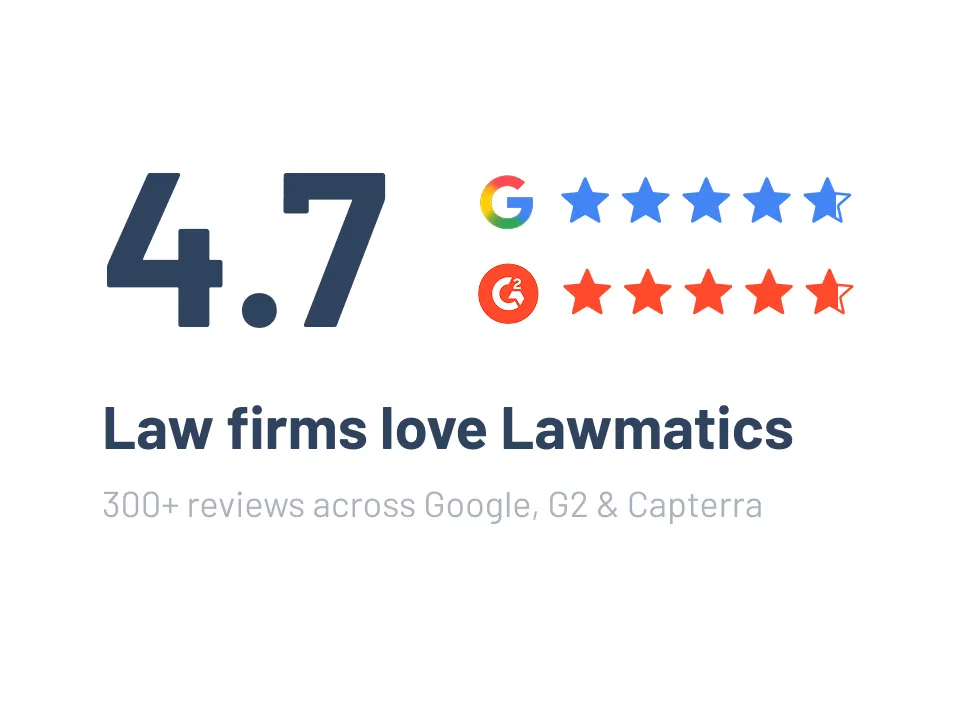







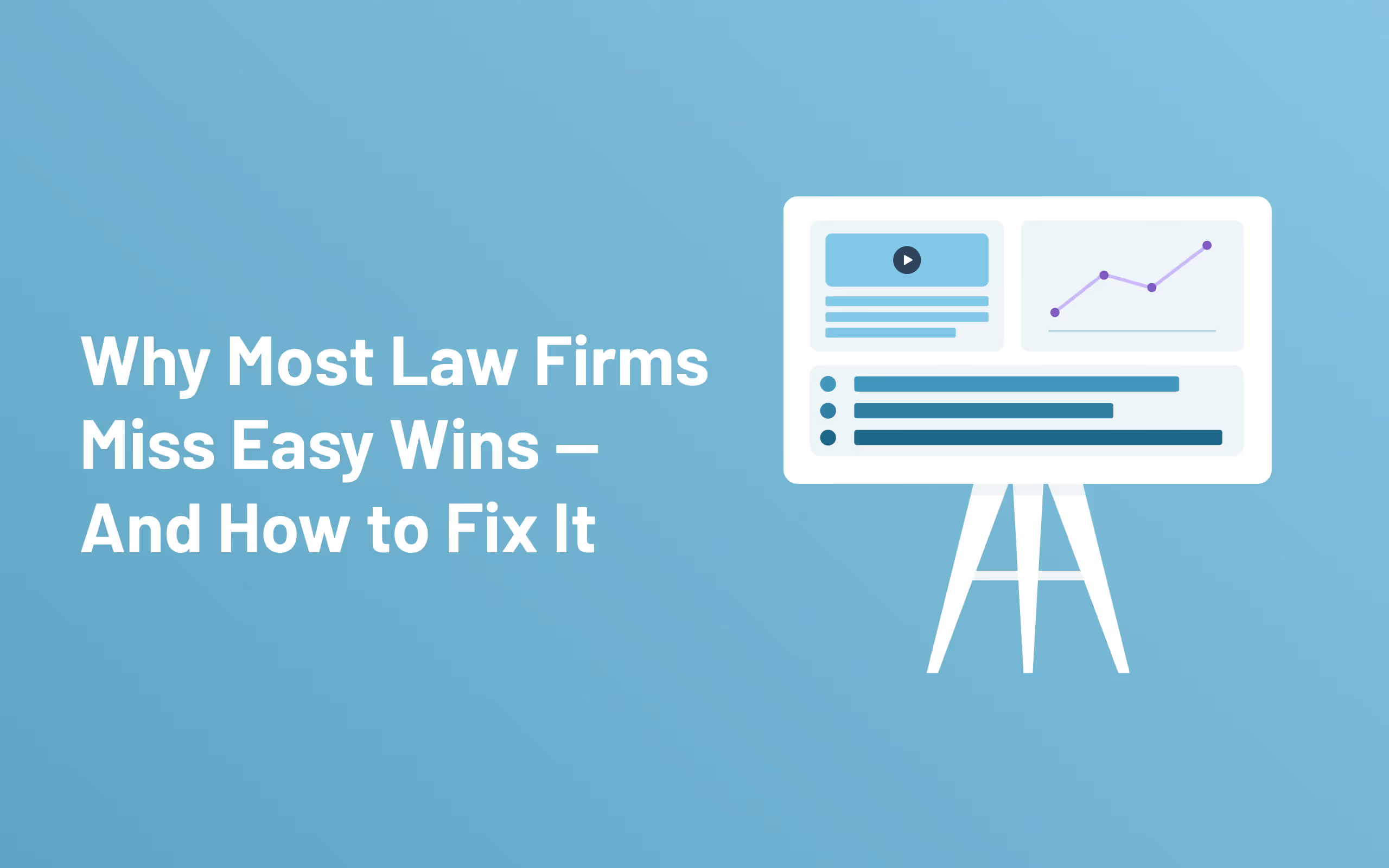
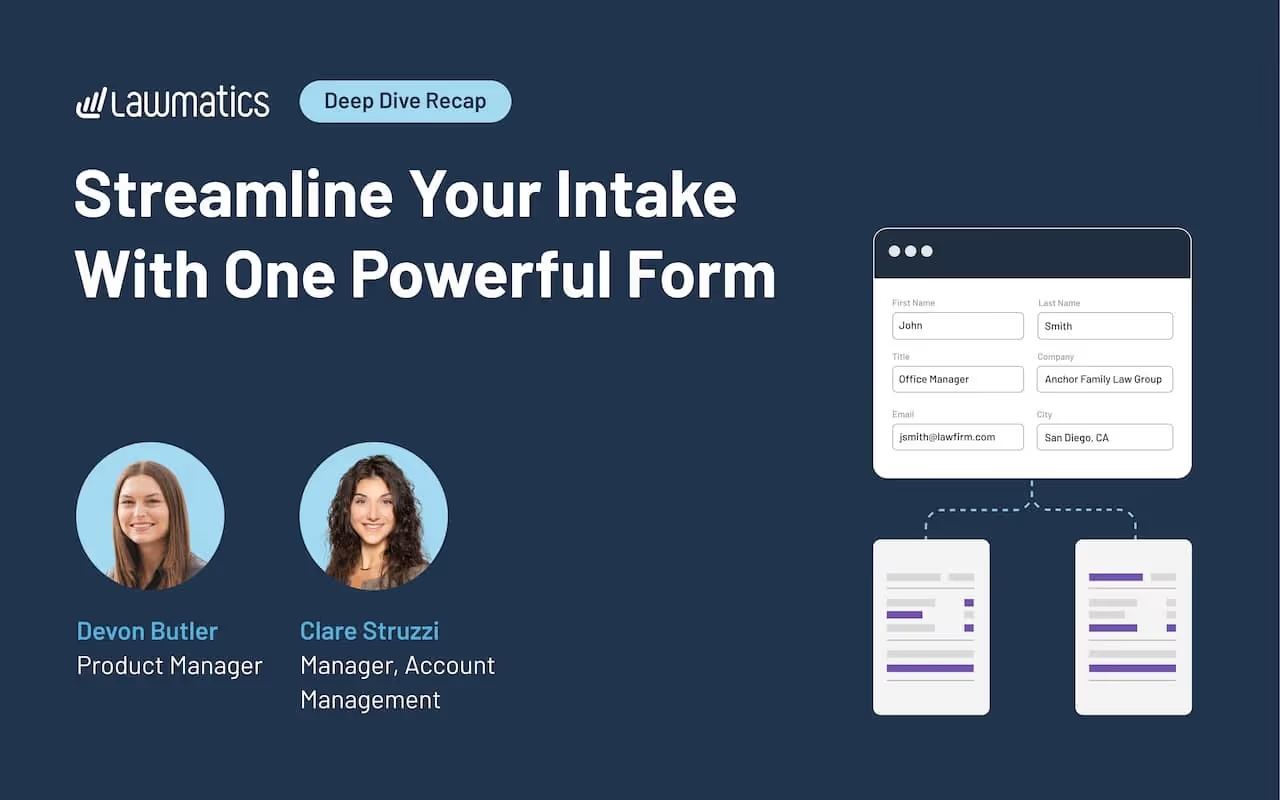
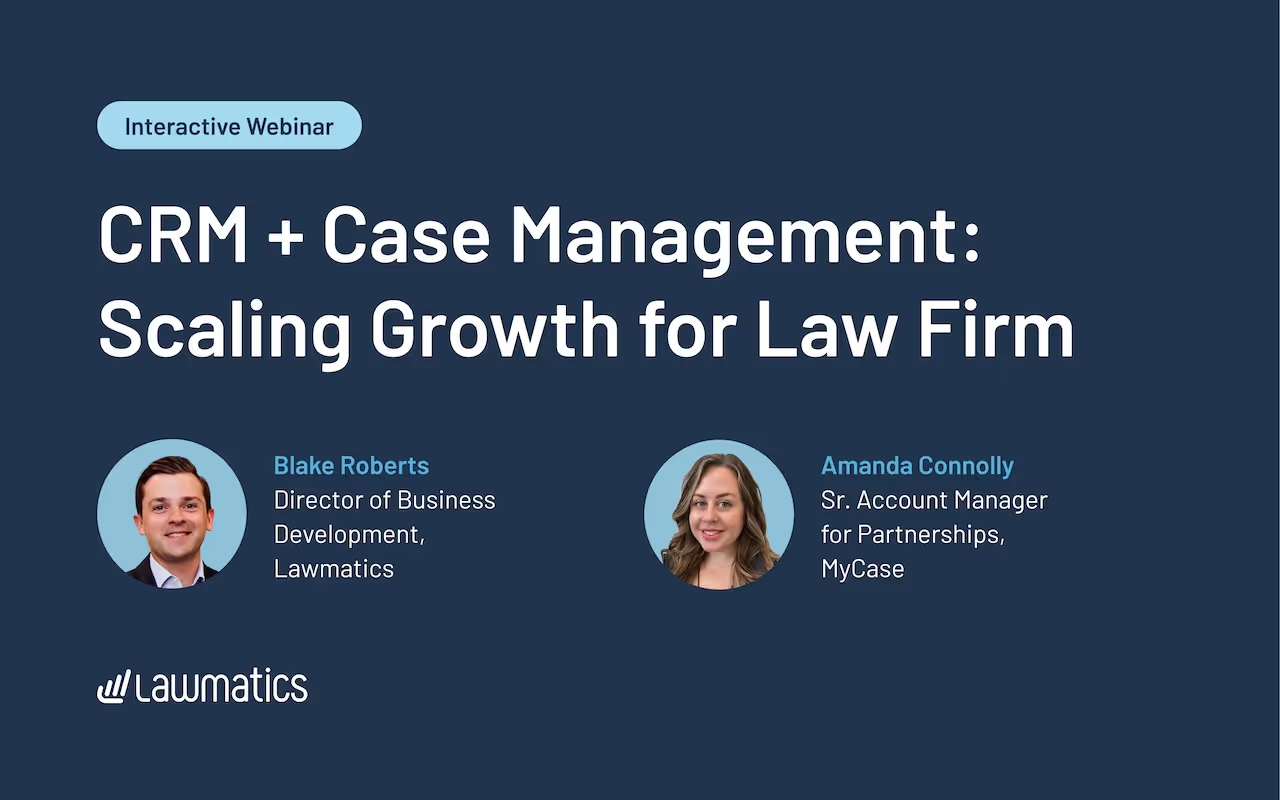
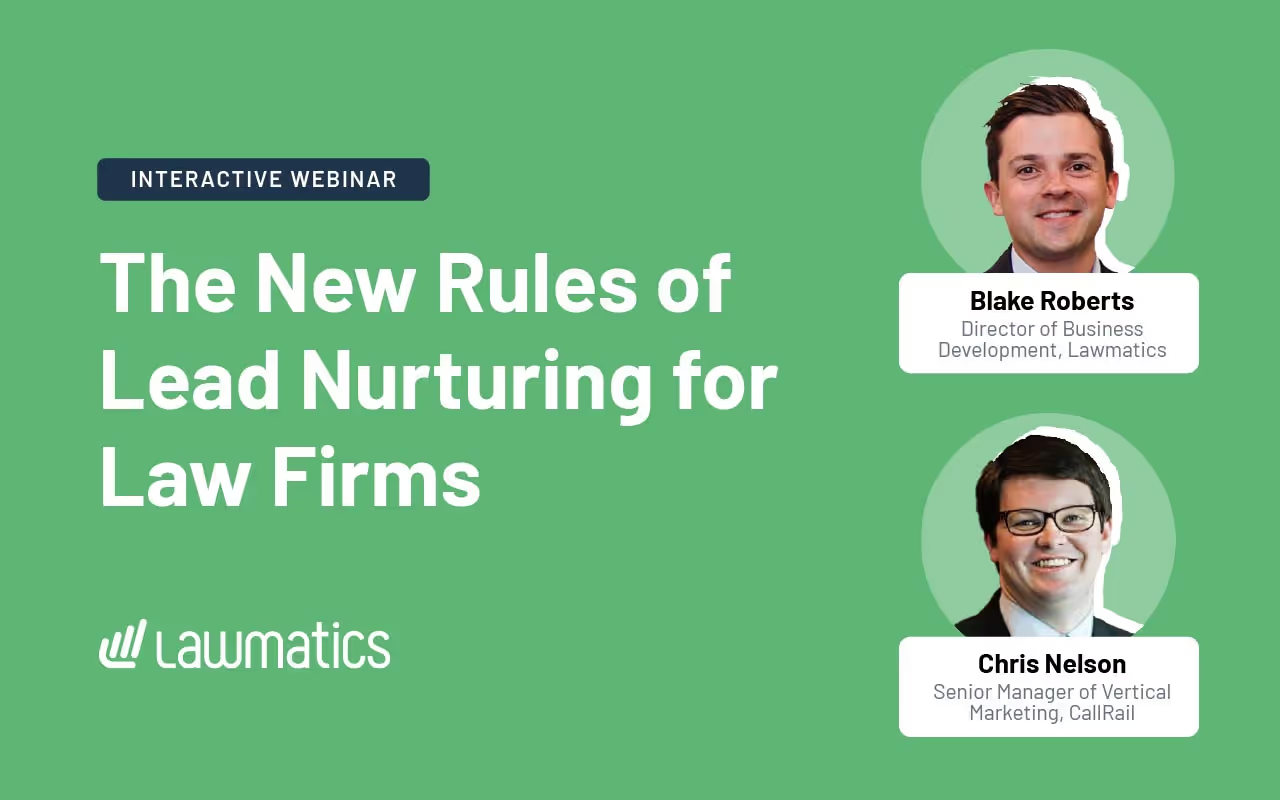


.avif)
.avif)

.avif)
